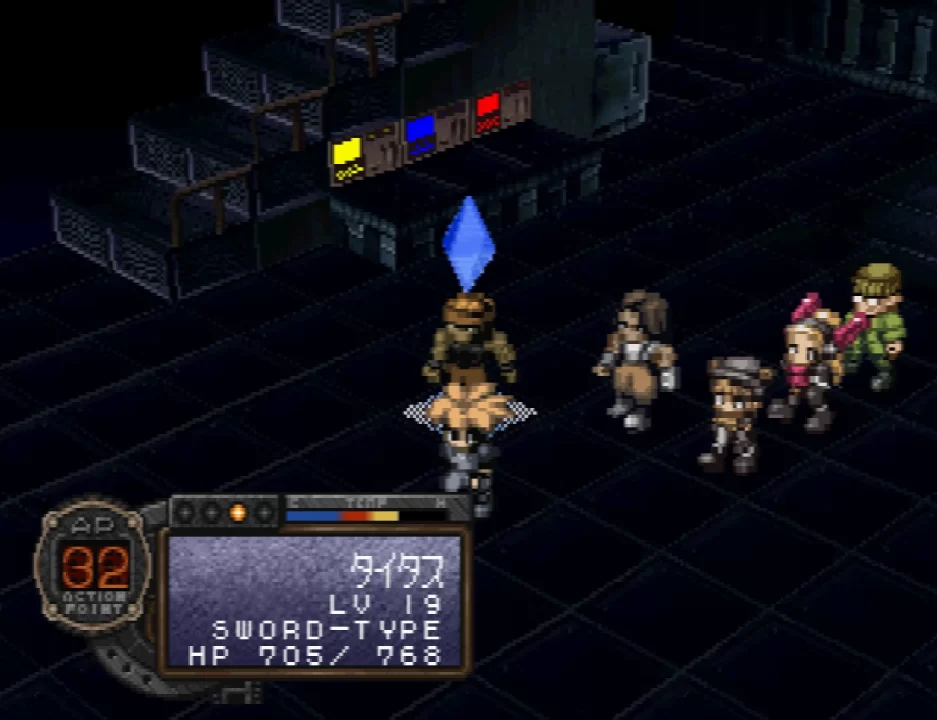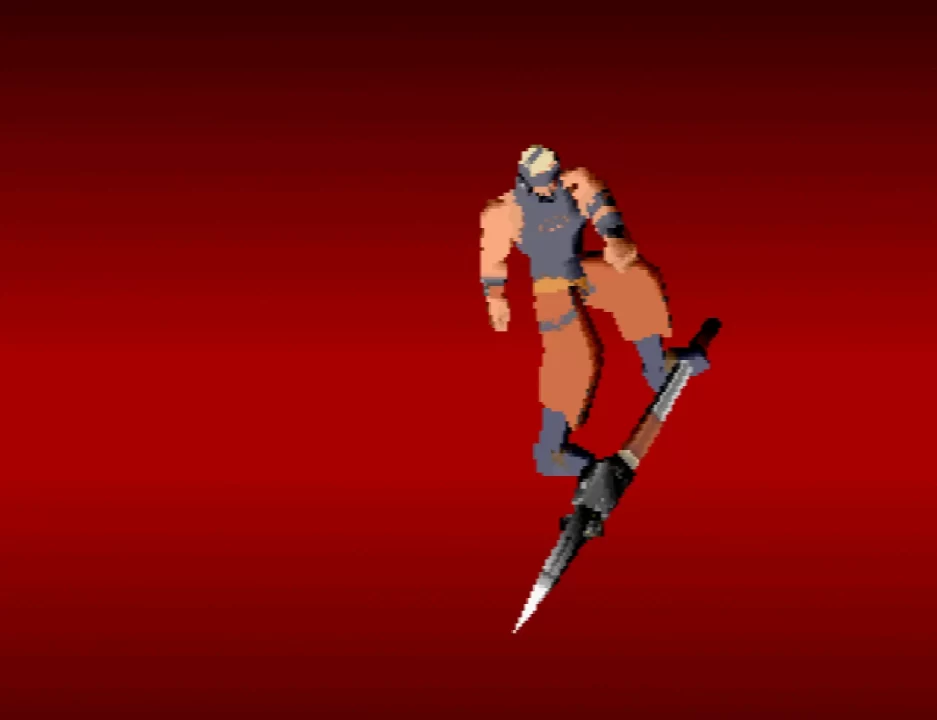Glenn A. Rudy III and Yumi Makita were two students at Penn State Harrisburg who quickly became friends. Early on, they decided to write a text translation for an obscure Sega Saturn tactical RPG called Wachenröder. The project stalled early when their friendship blossomed into love. Eventually, they managed to reach their goal and delivered this translation to the GameFAQs library. In contrast to this sweet love story, the beginning of Wachenröder is grim and tragic.
“It’s raining again. Damn the rain!” laments Lucian as the polluted precipitation pelts the panes of his place. “There is no God,” he thinks as he reflects on his own relative health while his twin sister lies at death’s door with a disease the dastardly deluge dealt her.
What a strong start. Not only is Lucian’s desperation and frustration sharply evident, but this moment (and almost the entire lengthy opening sequence) breaks the sacred “show, don’t tell” rule of narrative as it recounts Lucian’s fighting in an illegal fight club to earn money for his sister’s medicine. These brief paragraphs are conveyed in such an effective way that I couldn’t imagine it being more impactful, even if they showed those events or let you play them. You could make nearly an entire different game with these off-screen mentions. Yet, the game and Lucian sweep all that away and make it feel like a distant memory because Lucian just returned home to find an empty bed in his sister’s room. All that effort, all that pain, and none of it mattered.
There’s more to say about the plot, but gameplay-wise, Wachenröder is at once a refreshing take on the isometric turn-based tactical RPG and a baffling one. It strips away any need for equipment, grinding, and exploration. Like many games of its type, it’s a linear journey through battle sequences broken up by dialog, but it’s a zippy affair that never overstays its welcome and is easy to play in short bursts. The game’s total lack of difficulty enhances its short-session friendliness. You encounter opportunities to upgrade your equipment and purchase consumables, but I never once used a consumable in battle, and I stopped buying equipment halfway through. As far as weapons go, it seems only your main character earns new weapons, and only through story events.
There is the skeleton of tactical systems in this turn-based strategy RPG: you benefit from flanking your enemy, utilizing elevation, and exploiting environmental bottlenecks, but as long as you have at least one character who uses their infinite healing move — which takes very few action points and therefore can happen times during a single turn — and keep your main character safe, this game is a breeze no matter how tactically careless you are. In this way, it may be a decent entry point for newcomers to SRPGs.
The only real mitigating factor to absolutely wailing on enemies is the rudimentary heat management system. When you attack an enemy, you can press down on the d-pad to rev up your weapon. The more power you give it, the more damage it deals, but also the more heat it produces. The hotter your weapon gets, the less you can rev it. Additionally, you have access to perform an “Over Steam” special move that does massive damage, one-shotting the majority of enemies in the game, at the cost of yet more heat.
There is no notion of MP or any resource governing the use of your abilities. Everything relies on Action Points, which replenish every single turn. This makes “Over Steam” the right choice in most situations. About one-third through the game, you receive a number of godlike party members who are available for most of the missions and leave you little reason to replace them with others. However, even many of the normal characters can one-shot stage bosses all the same, so there’s little need to worry about who you bring with you when given the option.
It’s not every day you come across an isometric tactical RPG serving as a power fantasy, but Wachenröder fills that niche and can be refreshing because of it. Often, you can fight your way through stages in less than ten minutes. Only one comes to mind that provides any challenge at all, and that challenge is external to the combat. Instead, it has to do with how quickly you must achieve your objective.
As refreshing as a game like this can be, it’s impossible to deny that the lack of challenge ultimately points to a lack of depth. Disappointingly, much of the game feels unfinished, and the most pointed evidence of this is how quick and uninteresting many of the combat stages are. Many rely on switch-flipping and basic spatial puzzles that add nothing more than minor tedium. The utter lack of balance in combat is also a real head-scratcher. Your party’s ability to kill most enemies in one or two attacks and the unlimited healing specific characters can bring to a fight mean that the biggest challenge is finding the right switch to activate at the right time.
The unbelievably rough graphics further contribute to this unfinished feel. I never get too bent out of shape about the brown-grey color palettes of games from the 2010s, but this game is greyer and browner than most about a half-decade before that look was hip. Credit for being ahead of the curve, I suppose, but the most noteworthy thing about Wachenröder‘s visuals is how unpleasantly grungy it looks, or how the four camera angles you have access to on the battlefield all manage to get in your way more than they help you. Even the static images depicting cities or landscapes during some story segments fail to present anything particularly pleasant. The “Over Steam” attacks are accompanied by brief 3D animation cutaways like in Fire Emblem, which while truly dreadful to behold, carry a charm in their sheer, suffocating awfulness. On the other hand, the music is a strange mix of synth and modern instrumentation with orchestral elements that, despite being weird, quickly fade into the background.
Similarly, as refreshing as the beginning of the narrative is, it almost immediately sails into safer waters and, ironically, sinks. The absolute blunt force trauma of the opening lines uttered not by an optimistic young future hero, but a desperately miserable and cynical youth, moves sharply into a scene that expresses his desperation through his murder of a stranger. This leads to the aforementioned “tell, don’t show” sequence briefly detailing his short career as a combat athlete, culminating in him coming home with prize money for his sister’s medicine, only to find she’s no longer there. The off-screen scoldings of Lucian’s father, asking where he was and why he wasn’t by his sister’s side in her last moments, really make you believe you’re in for something special.
In a cruel twist for players interested in a uniquely brutal story, the tragic and violent beginning settles into a much more predictable tale of ousting an evil dictator to restore the righteous monarch to his perch. This is a painful irony given the anarchistic leaning the beginning suggests. The political environment of the nation the game takes place in is fun enough. It features an indigenous people who protect the forest, contrasting with the extractionist industrialists that govern the polluted cities you visit, but unfortunately doesn’t provide anything unique in tone or substance.
Thus, not many of the scenarios offer much in terms of narrative. Some of the characters are fun, but few stand out. For the most part, who they are when you meet them is who they remain when you leave them, and although a few of the more experienced, competent characters — the ones who do most of the talking — are intriguing, the rest of them fail to inspire much interest.
Quite often, I find a certain intrigue in games that are difficult to recommend. I’m uncertain about Wachenröder, though, as it almost seems to be the opposite scenario. In light of the spectacular first fifteen minutes, which promise an experience it cannot deliver in the end, Wachenröder must be classified as a failure. I have a strong urge to recommend it anyway. There isn’t a Final Fantasy Tactics-style isometric tactical RPG anywhere that’s this easy, or rather, gives the player such an outsized power fantasy without extensive theory crafting or min-maxing. I largely had fun playing Wachenröder because there is a rare sort of glee that comes from setting up and knocking down big-talking bad guys in a game like this. It’s a disappointment in key ways, but at times it’s hard to put down. It’s not essential, but it’s a baffling curio, and sometimes that’s enough to keep one engaged for longer than one might think.





